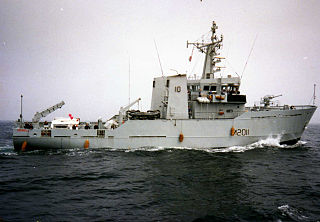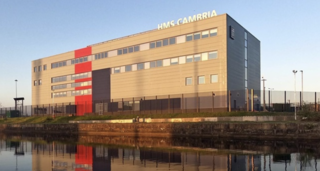
The River class was a class of minesweeper built for the British Royal Navy in the 1980s, designated Fleet Minesweepers (MSF).

The British Royal Navy operated large numbers of small Motor Minesweepers (MMS) during the Second World War, in two major classes: the first with 105 ft (32 m) hulls and the second with 126 ft (38 m) hulls. Intended to counter magnetic influence mines in coastal waters, they had wooden hulls.
Seven ships of the Royal Navy have been named HMS Venturer, with an eighth announced:

The Venturer-class minesweepers were naval trawlers converted from fishing trawlers to minesweeper service for the Royal Navy in 1978.

The Royal Naval Patrol Service (RNPS) was a branch of the Royal Navy active during both the First and Second World Wars. The RNPS operated many small auxiliary vessels such as naval trawlers for anti-submarine and minesweeping operations to protect coastal Britain and convoys.

Naval trawlers are vessels built along the lines of a fishing trawler but fitted out for naval purposes; they were widely used during the First and Second World Wars. Some—known in the Royal Navy as "Admiralty trawlers"— were purpose-built to naval specifications, others adapted from civilian use. Fishing trawlers were particularly suited for many naval requirements because they were robust vessels designed to work heavy trawls in all types of weather, and had large clear working decks. A minesweeper could be created by replacing the trawl with a mine sweep. Adding depth charge racks on the deck, ASDIC sonar below, and a 3-inch (76 mm) or 4-inch (102 mm) gun in the bow equipped the trawler for anti-submarine duties.
Three ships of the Royal Navy have borne the name HMS St David, after Saint David, patron saint of Wales:
His Majesty's or HM Armed Smack Inverlyon was a fishing smack that was converted to a Q-ship during the First World War. Q-ships served as decoys to lure German submarines near enough so that concealed weapons could be brought to bear and sink the submarines. On 15 August 1915, Inverlyon succeeded in luring German submarine UB-4 within range and sinking her with nine shots from her gun. The Royal Navy Gunner in command of the vessel, Ernest Martin Jehan, received the Distinguished Service Cross and members of Inverlyon's crew shared the bounty offered for German submarines. After Inverlyon's Q-ship career ended, she returned to fishing, but was sunk by U-55 on 1 February 1917.

Mincarlo is the last surviving sidewinder fishing trawler of the Lowestoft fishing fleet. She is also the last surviving fishing vessel built in Lowestoft, with an engine made in the town.

The Overseas Patrol Squadron is a front-line squadron of the Royal Navy with responsibility for patrolling the UK's Extended Fisheries Zone, both at home and around British Overseas Territories. The squadron, with headquarters at HMNB Portsmouth, is equipped with eight of the River-class patrol vessels.

HMS Cambria is the lead Royal Naval Reserve unit in Wales. It is based at Sully near the Welsh capital, Cardiff.

RV George Bligh (LO309) was a fisheries research vessel that was operated by the Directorate of Fisheries, now known as the Centre for Environment, Fisheries and Aquaculture Science (Cefas).
The SY Hildegarde and the SY Hiawatha were steam yachts chartered by the Ministry of Agriculture, Fisheries and Food - Directorate of Fisheries, now known as the Centre for Environment, Fisheries and Aquaculture Science (Cefas) between 1912 and 1914 to carry out fishery investigations.
Junella was a fishing trawler, best known for her service with the Royal Navy during the Falklands War. She was built in 1975 for J Marr & Son, a Hull-based fishing company. On 11 April 1982 she was taken up from trade by the British government and commissioned into the Royal Navy. She was fitted with Second World War era minesweeping gear at Rosyth Dockyard, manned by Royal Navy sailors and allocated to the 11th Mine Countermeasures Squadron. She sailed on 26 April but was unable to commence sweeping until after the 14 June Argentine surrender. In the meantime she was utilised to transfer troops and stores between ships and landed special forces troops at San Carlos. Demining operations commenced on 21 June. Junella returned to the United Kingdom on 11 August, carrying a defused Argentine mine.
Richards (Shipbuilders) Ltd was a shipyard in Lowestoft, Suffolk.
Type 8105 naval trawler is a Chinese auxiliary ship of the People's Liberation Army Navy (PLAN). Type 8105 along with Type 792 and Type 8154 naval trawlers have all received NATO reporting name FT-14 AIT class, meaning Fishing Trawler - 14 Auxiliary Intelligence-gathering Trawler. After retiring from their original role of a spy ship, Type 8105 naval trawlers have been converted to auxiliary minesweepers and survey vessels, and kept in operational reserve of the Chinese navy.
Type 792 naval trawler is a Chinese auxiliary ship of the People's Liberation Army Navy (PLAN), deployed as intelligence gathering spy ship. Type 792 and its predecessor Type 8154, along with Type 8105 naval trawlers have all received NATO reporting name FT-14 AIT class, meaning Fishing Trawler - 14 Auxiliary Intelligence-gathering Trawler.
Carl Röver was a German fishing trawler which was requisitioned by the Kriegsmarine in the Second World War for use as a vorpostenboot, serving as V 209 Carl Röver and V 203 Carl Röver. Severely damaged in the war, she was repaired post-war and re-engined. She served as the fishing trawler Essen and was later converted to a cargo ship. She served as Hans Peter, Handsome, Handsome I, Walid and Samir under the flags of West Germany, the United Kingdom, Panama and the Lebanon. She was lost in 1985.

HMS Venturer is a Venturer-class minesweeper converted from the trawler Suffolk Harvester for the Royal Navy in 1978.








